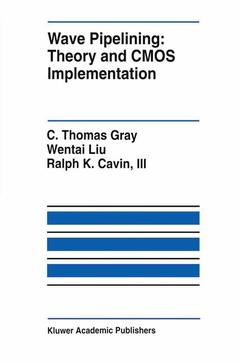Description
Wave Pipelining: Theory and CMOS Implementation, 1994
The Springer International Series in Engineering and Computer Science Series, Vol. 248
Authors: Gray C. Thomas, Wentai Liu , Cavin, III Ralph K.
Language: English
Subject for Wave Pipelining: Theory and CMOS Implementation:
Keywords
CMOS; algorithms; logic; model; tables
158.24 €
In Print (Delivery period: 15 days).
Add to cart
Publication date: 09-2012
206 p. · 15.5x23.5 cm · Paperback
206 p. · 15.5x23.5 cm · Paperback
Description
/li>Contents
/li>
The quest for higher performance digital systems for applications such as gen eral purpose computing, signal/image processing, and telecommunications and an increasing cost consciousness have led to a major thrust for high speed VLSI systems implemented in inexpensive and widely available technologies such as CMOS. This monograph, based on the first author's doctoral dissertation, con centrates on the technique of wave pipelining as one method toward achieving this goal. The primary focus of this monograph is to provide a coherent pre sentation of the theory of wave pipelined operation of digital circuits and to discuss practical design techniques for the realization of wave pipelined circuits in the CMOS technology. Wave pipelining can be applied to a variety of cir cuits for increased performance. For example, many architectures that support systolic computation lend themselves to wave pipelined realization. Also, the wave pipeline design methodology emphasizes the role of controlled clock skew in extracting enhanced performance from circuits that are not deeply pipelined. Wave pipelining (also known as maximal rate pipelining) is a timing method ology used in digital systems to increase the number of effective pipeline stages without increasing the number of physical registers in the pipeline. Using this technique, new data is applied to the inputs of a combinational logic block be fore the outputs due to previous inputs are available thus effectively pipelining the combinational logic and maximizing the utilization of the logic.
1 Introduction and Motivation.- 1.1 Wave Pipelining.- 1.2 History.- 1.3 Designing Wave Pipelined Circuits.- 1.4 Organization.- 2 Clock Period Constraints: Single Stage Systems.- 2.1 Introduction.- 2.2 System Model.- 2.3 Constraints for Correct Clocking.- 2.4 Minimizing the Clock Period.- 2.5 The Parameter k.- 2.6 Special Cases.- 2.7 Conclusions.- 3 Clock Period Constraints: Multiple Stage Systems.- 3.1 Introduction.- 3.2 System Model.- 3.3 Constraints for Correct Clocking.- 3.4 Example.- 3.5 Conclusions.- 4 Exact Timing Analysis.- 4.1 Introduction.- 4.2 Motivation and Justification.- 4.3 Complexity of Problem.- 4.4 Notation and Model.- 4.5 Basic Algorithm Development.- 4.6 Conclusion.- 5 Exact Timing Analysis: Algorithm.- 5.1 Introduction.- 5.2 Algorithm Strategy.- 5.3 Calculation of Output Responses.- 5.4 Verification of Output Responses.- 5.5 Detection of Components.- 5.6 Vector Reporting.- 5.7 Implementation.- 5.8 Limitations and Extensions.- 5.9 Conclusion.- 6 Practical Considerations in Wave Pipelining.- 6.1 Architecture Choice.- 6.2 Path Delay Variation.- 6.3 Circuit Choice.- 6.4 Parametric Variations due to Manufacturing and Environmen-tal Factors.- 6.5 Clock Distribution and Physical Layout.- 6.6 Technology Scaling.- 6.7 Conclusion.- 7 Design Examples.- 7.1 Introduction.- 7.2 Parallel-Carry Adder.- 7.3 Sampler.- 7.4 Conclusion.- 8 Conclusions.- A Example Model File.- B Calculation of Tolerance of Parametric Variations.- References.
© 2024 LAVOISIER S.A.S.
These books may interest you

Essentials of Computer Architecture 105.47 €



